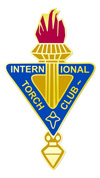
Meeting Minutes
Torch Club of the Fox Valley
10 April 2014
Atlas Coffee Mill & Café
Notes taken by: Jude Kuenn, secretary
Attendees: Jim Baumbach, Nancy Bodway, Al Button, Janet Wullner-Faiss Cloak, Dwight Easty, Paul Freiberg, Jean Jepson, Jude Kuenn , Mary Poulson, Richard Schoenbohm, Jan Smith, Bob Swain, Peter Thiel, Scott Valitchka
Guest: Betsy and Bill
BUSINESS MEETING
Meeting called to order at 6:45pm
- Guests: Betsy and friend Bill, visiting from Allentown, PA, were welcomed.
- Minutes from 3/13/14 meeting were accepted, motioned and approved.
- Treasurer’s report: April balance unchanged from March at $1,437.69. Handouts of Barbara’s 2013-2014 Torch Income and Expense recap were reviewed. Reports were accepted, motioned and approved. Peter expressed concern regarding the dollar balance. In Barbara’s absence, Richard advised she is aware of Peter’s concern and proposed a Summer Board meeting to review account’s status. There will be a preliminary (Board) review, then a general meeting invitation, looking forward at the Club’s financial health.
- Bob recruited 2014-2015 speakers, noting annual orientation is 9/14; Jean has asked for 10/14 and Neal would like to present at 11/14 meeting. That leaves six open evenings for speakers. A sign-up sheet was passed around the table twice and all slots were filled for next year. To Jean’s question: ‘How long should a talk be?’ target 35 minutes to allow discussion time afterwards.
- Old Business -
a. Torch International Survey – please complete and return to Richard. He will assemble all feedback and submit one completed survey by IATC by 4/30/14.
b. Status of Delegates - with Donna and Janet unable to attend, Richard will contact Bill and Barbara as possible Delegates to the International Torch Club’s Annual Conference, 6/19-22/14 in St. Catherines (Niagara), Ontario, Canada. Richard may consider himself an Alternate. Per 3/13/14 meeting, the Club will cover registration fee for each delegate. Delegates are to register and send their check to IATC; the Club will reimburse them. Richard will advise IATC names of Fox Valley Chapter Delegates. - New Business -
- Announcements -
Mary – Steve Polansky, noted author, will talk at 4/16/14 Noon Hour Philosophers meeting.
Jan - Bergstrom-Mahler Museum of Glass’ new show features Bullseye Glass of Portland, OR. It is a retrospective of fused, kiln-formed glasswork. Show opens 4/12/14 with curator/member opening reception Monday 4/14/14. Another exhibit in collaboration with PAC is “Changed for the Good” an eight-week project reflecting students’ personalities. Kids worked with Bullseye Glass.
Business segment adjourned at 7:15pm for dinner.
Package bees, 3 lbs. = 10m bees, can be ordered via US Post to get started or replenish a hive. Good hive location faces east with full sun and an adjacent wind block. Water in close proximity plus level ground is also important to hive site. One is a big deal, more is not. Many hives allow more versatility if a queen dies unexpectedly. Wintering hives require little maintenance, bees cluster to stay warm, not allowing inside temperature to sink below 68F. When a queen starts laying eggs again, temp will raise another 10F to keep young brood warm.
Basic unit of hive was defined, along with smoker use and a beekeeper’s garb. Lorenzo Langstroth, 19th century beekeeper identified bee space, .25” to .375” around frames bees maintain to work combs. He also is credited with creating moveable frames for managing a hive and making honey harvesting easier. A hive tool allows a keeper to break any built up propolis or bee glue bees make to weld shut any cracks in the hive, preventing drafts.
Drones (male), workers (female) and queen’s life cycle and hive habits were shared. Royal jelly is fed all three types of larvae for first three days fertilized egg is laid in comb. Thereafter, only the queen larvae receive royal jelly for full female reproductive development. As a virgin, she is urged to the entrance for her nuptial flight, mating with drones, storing sperm to last her lifetime. Fed, stroked and groomed, the worker bees intimately know her health. When failing, they will decide to make a new queen, a process called supersedure.
Workers have stiff hairs which gather pollen granules from flowers. Once covered, the worker will stop, pack granules into baskets in rear legs and return to the hive. House bees will arrange the pollen in the honeycomb around bee larvae, available to nurse bees once they emerge.
Bees communicate via chemicals or scented pheromones, unique to each hive. A second communication method is tactile: bees tell each other about food or home location by patterned motions called ‘bee dances’. There are guard bees and scouts, all working for the colony.
Feeding habits are continuous and instinctive. Stinging affects folks differently and causes the worker’s death once her stinger has been left on-site.
Bees’ vision is myopic, they are more sensitive to broken patterns, flickering light and/or and sudden movement. They see ultraviolet, which guides them to nectar. They cannot see red.
Most bees in the U.S. are Italians, imported and developed by Langstroth.
‘Busy as a bee’ is a bit of a misnomer; studies have found they only work two-thirds of an observed time. Swarming occurs when the colony feels over-crowded; the queen will leave with the swarm, usually occurring in spring.
Bee diseases have been on the rise due to various environmental factors.
Honey is made by evaporating the water in nectar and inverting its complex sugars. Once done, bees will cap cells of with wax, the honey having less than 19% water. Hygroscopic, a beekeeping must harvest honey managing temperature and humidity. Color, aroma and flavor reflect blossoms and honey taste.
Final meeting Thursday 5/08/14. Bob to chair evening in Richard’s absence.